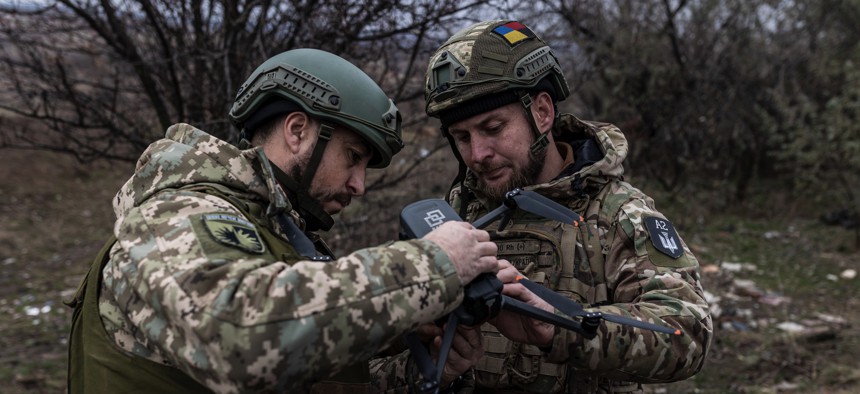SAM SKOVE

As Ukraine leans on suicide drones to wear down Russia’s invading forces, private, civilian-run training schools are working to supply the Ukrainian army with thousands of pilots.
That’s no mean feat. The drones are extremely hard to fly, requiring weeks of training before a pilot is ready to fight on the front line.
“The chance that you will literally fly into a wall during training is higher” than with other types of drones, said Ihor Dvoretskyi, a project manager with Ukraine’s Defense Ministry who also volunteers with Victory Drones, one of the country’s largest drone education centers.
More formally known as loitering munitions, suicide drones have emerged as a key weapon of the war, with both sides using them in large numbers. Some are sophisticated, purpose-built munitions, but many are hobbyist racing drones adapted to serve as flying improvised explosive devices. Such drones are also known as first-person view (FPV) drones, after the goggles used to fly them.
“In every area, they’re using FPV drones,” said Yehor Cherniev, deputy chairman of the Ukrainian parliament’s Committee on National Security, Defence and Intelligence. “They’re a cheap weapon, and a weapon that сan be used en masse.”
But it takes longer to learn to fly them than, say, the hardware-and-software-stabilized photography quadcopters used across Ukraine’s frontline to coordinate artillery.
“You are literally flying this drone like it was a Cessna [plane] from the 1960s,” said Dvoretskyi.
To simplify the task, FPV drones typically fly in airborne teams with photography drones that sport a wider range of view and advanced zoom lenses. The operators of the photo drones mark the GPS coordinates of Russian vehicles and soldiers for the FPV pilots.
“FPV drones can’t exist without [photography drones],” said Anton Frolov, the lead instructor at the Kruk drone-operator school in Kyiv.
Highly motivated students can become good FPV pilots in around 30 days, with pilots learning theoretical knowledge, flying, and even how to repair drones in that time period, according to Maria Berlinska, the founder of Victory Drones.
In addition to pilot training, VIctory Drones runs a vast web of other resources, including seminars on drones, education on how to assemble FPV drones, and courses in using battlefield intelligence software programs like Ukraine’s homegrown Kropiva program.
Berlinska, a longstanding advocate for Ukrainian women’s role in the military, also launched an initiative to train female drone pilots.
“This is a technological war,” she said. “It’s not so important to be very physically strong, you have to be strong in your mind.”
Training at Kruk runs slightly shorter, clocking in at two weeks. Frolov said the training has been compressed to accommodate the needs of the war. The Kruk course includes several hours on how to build FPV drones.
Frolov said students start by using flight simulators similar to what’s available on video game site Steam. They then move onto field exercises, with students practicing strikes on a fridge-sized robot driving at around 10 miles an hour.
The most talented pilots are used to playing computer games, he said. People with “PlayStation experience” do better, Dvoretskyi agreed.
In the last ten months, Victory Drones has prepared a thousand FPV pilots, making a total of 38,000 graduates in the school’s various programs. Berlinska said. Kruk has trained around 800 FPV pilots at a rate of 80 a month, for a total of 3,300 drone pilot graduates.
Berlinska estimates the country needs 10,000 FPV pilots in its one million-strong military. It’s unclear how many drone pilots are currently trained, given that training is done at civilian-run training centers, like Kruk and Victory Drones.
Everyone, though, needs to have some level of familiarity with FPV drones, said Berlinska. “Ideally, every soldier could use a drone like they could a rifle.”
Ukraine’s efforts, as is typical for the cash-strapped country, are constrained by finances, especially given the time-consuming process for training FPV pilots.
Such centers may receive funding from Ukraine’s government. Frolov said that Kruk had received government funding but that it had ended, leaving them to support operations through fundraising activity.
“It’s a tough time for us,” he said.
With more money, Berlinska said Victory Drones could expand training, and add in more training to focus on electronic warfare. The cost of training a soldier on quadcopters is around $35, while the cost of training an FPV pilot is six to seven times that cost, she said.
The school also hopes to expand training for rescue teams. “We know that this winter there will be a lot of missile attacks against civilian infrastructure,” said Berlinska. “We’d like to train rescue teams on how to find people under the debris.”
No comments:
Post a Comment